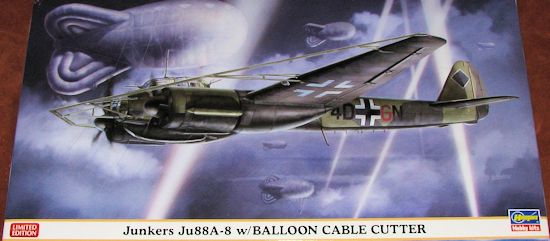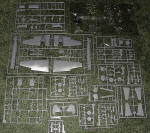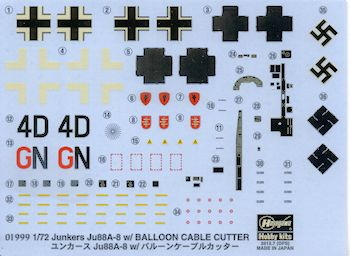
Hasegawa 1/72 Ju-88A-8 w Balloon Cable Cutter
| KIT #: | 01999 |
| PRICE: | $35.57 on sale ($72.99 SRP) |
| DECALS: | Two options |
| REVIEWER: | Scott Van Aken |
| NOTES: | Includes photo etched parts. 2012 boxing |

| HISTORY |
The Junkers Ju 88 was a World War II German Luftwaffe twin-engine, multi-role aircraft. Designed by Hugo Junkers' company in the mid-1930s to be a so-called Schnellbomber which would be too fast for any of the fighters of its era to intercept, it suffered from a number of technical problems during the later stages of its development and early operational roles, but became one of the most versatile combat aircraft of the war. Affectionately known as "The Maid of all Work" (Mädchen für Alles), the Ju 88 proved to be suited to almost any role. Like a number of other Luftwaffe bombers, it was used successfully as a bomber, dive bomber, night fighter, torpedo bomber, reconnaissance aircraft, heavy fighter, and even as a flying bomb during the closing stages of conflict.
Despite its protracted development, the aircraft became one of the Luftwaffe's most important assets. The assembly line ran constantly from 1936 to 1945, and more than 16,000 Ju 88s were built in dozens of variants, more than any other twin-engine German aircraft of the period. Throughout the production, the basic structure of the aircraft remained unchanged.
One of those specialized variants was the Ju-88A-8. This was a standard Ju-88A-4 that was fitted with the large and somewhat cumbersome balloon cable cutter device that ran from wing tip to wing tip and was supported by large struts. It severely affected the center of gravity of the aircraft so a considerable amount of weight was placed in the tail section to balance things outs. This set up also reduced the speed of the plane making it an easy target for defending fighters. Despite these drawbacks, the system was effective in cutting cables of all sizes or shunting them around the airframe.
| THE KIT |
 This
is pretty well the standard Hasegawa Ju-88A-4 with the addition of a single
photo etch fret containing the cable cutter assembly. To refresh your memories;
This
is pretty well the standard Hasegawa Ju-88A-4 with the addition of a single
photo etch fret containing the cable cutter assembly. To refresh your memories;
Hasegawa couldn't have picked a better aircraft in terms of the ability to do subtypes. The Ju-88 has to have been used in more different roles than just about any other German WWII aircraft. This is particularly obvious when one looks at the sprues and notes the myriad of parts and inserts that are provided.
Molded in Hasegawa's usual medium grey plastic, this
one is just as superbly molded as one would expect from Japan's premiere model
airplane maker. Some things we have come to expect are a nicely done but
somewhat Spartan interior than relies on decals for instruments. There there are
optional seats for the pilot, one of them being armored. It is not surprising
that the nose and aft fuselage
 are separate as often times the difference in
types is with different noses. In addition to the cable cutter bits, the photo
etch fret includes gun sights for the defensive machine guns and a pair of small
rack style antennas under the fuselage. The instructions suggest building up the
model and painting it prior to attaching the cable cutter and I would agree with
that assessment as it is easier to touch up paint than to paint around the photo
etch.
are separate as often times the difference in
types is with different noses. In addition to the cable cutter bits, the photo
etch fret includes gun sights for the defensive machine guns and a pair of small
rack style antennas under the fuselage. The instructions suggest building up the
model and painting it prior to attaching the cable cutter and I would agree with
that assessment as it is easier to touch up paint than to paint around the photo
etch.
This version has the liquid cooled Jumo engines and you
have the option of shrouded exhaust, depending on the decal option. Also
separate are wing tips, again to take into account the different variants. This
kit has four under wing bomb racks with bombs. There are also different
antenna options. The lower fuselage gondola comprises four parts in clear
plastic. Dive brakes are also provided as
 all A-4 versions were supposed to have
this capability. The main cabin has a number of transparencies as well. This kit
contains the dual rear guns so the cockpit glass is in three parts to more
accurately mold the rather complex aft section's shape. There are also four
small clear bits to attach before the 'beetle nose' front piece. Masking all this
will take a bit of time and personally, I'd attach the clear bits prior to
gluing on the wings so that masking will be a bit easier to do.
all A-4 versions were supposed to have
this capability. The main cabin has a number of transparencies as well. This kit
contains the dual rear guns so the cockpit glass is in three parts to more
accurately mold the rather complex aft section's shape. There are also four
small clear bits to attach before the 'beetle nose' front piece. Masking all this
will take a bit of time and personally, I'd attach the clear bits prior to
gluing on the wings so that masking will be a bit easier to do.
Instructions are the standard Hasegawa fare with Gunze paint references. Markings are for two planes painted in RLM 70/71 uppers with black undersides. The box art plane is from 5./KG 30 and has standard markings and codes. The other may be fictitious and is with 8./KG 76. This one has all of the insignia painted out. Decals are nicely done and include the instrument decals for the interior.
| CONCLUSIONS |
The inclusion of the photo etch balloon cutter makes for an interesting addition to this kit and also takes it out of the realm of many modelers and into that of the experienced modeler. Attaching the photo etch will be quite a challenge, however the instructions are quite good and provide several construction steps to help in this area. The end result will be a very nice model that will be unique amongst your collection.
| REFERENCES |
http://en.wikipedia.org/wiki/Junkers_Ju_88
June 2013
Thanks to your editor
for the preview kit. If you would like your product reviewed fairly and fairly quickly, please
contact
the editor or see other details in the
Note to
Contributors.